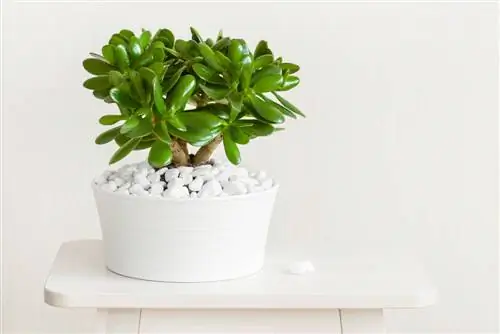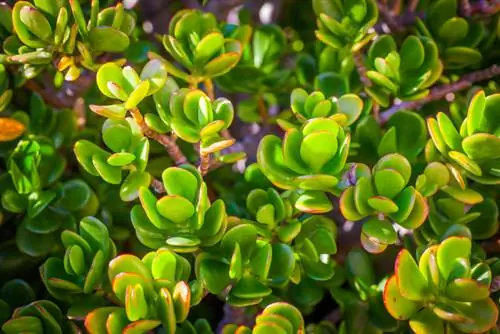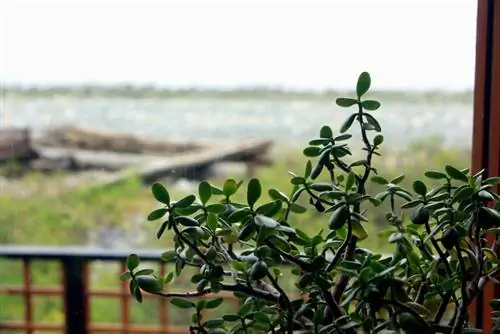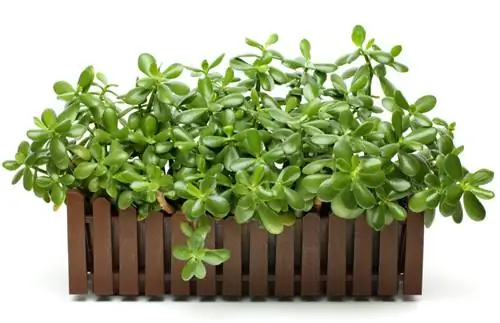- Author admin [email protected].
- Public 2023-12-25 17:45.
- Last modified 2025-06-01 06:02.
The money tree (Crassula ovata) is considered a good luck charm in many parts of the world, which is why many people like to give such a plant as a guest or birthday present. In general, the thick-leaf plant is a popular houseplant: easy to grow, easy to care for and growing in size over the years and with age, the plant adorns bright living rooms and other rooms. Even children really enjoy the non-toxic plant, as they can learn and practice proper plant care.
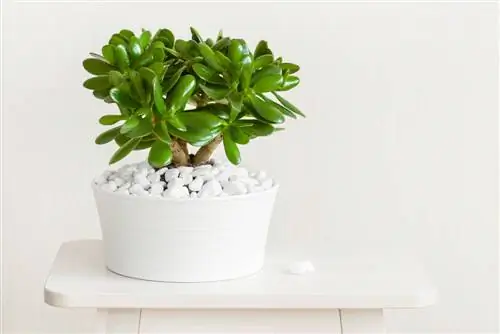
What makes the money tree special as a houseplant?
The money tree (Crassula ovata) is a popular, easy-care houseplant from South Africa that is said to bring good luck. It is characterized by dark green, fleshy leaves, a bush-like growth and resistance to pests. Propagation is easy via head or leaf cuttings.
Origin and distribution
The money tree (Crassula ovata), also known as the penny tree, thickleaf tree, elephant tree or bacon oak, is one of around 300 different species of the thickleaf family (Crassulaceae). The succulent plant is originally from South Africa, where it thrives on barren, rocky substrates in the company of other succulents such as aloe or euphorbia.
Usage
The attractive shrub with its large, thick leaves has been cultivated as an uncomplicated houseplant for many decades. Since the plant, which comes from hot Africa, is not hardy here, it is not suitable for pure garden cultivation. However, you are doing the money tree something good if you give it a pleasant spot on the balcony or terrace in the warm summer months and bring it back into the house when the temperatures drop in autumn.
Appearance and growth
Crassula ovata develops within a few years from a small, single-shoot mini plant into a tree up to 100 centimeters high with a thick trunk and strong branches. The species can be many decades old and very extensive: While the evergreen shrub reaches a height of up to 2.5 meters in a natural location in its homeland, even in pot culture it can grow significantly larger than up to one meter - and at least just as wide.
The money tree increases in height and size, especially when it is young. On the other hand, if the plant is a little older, the trunk and branches in particular will increase in size. Individual main shoots can reach a diameter of up to six centimeters. This growth in thickness is particularly important because otherwise the heavily branched shrub can no longer support its numerous, very thick leaves. The bark is usually gray-green to brownish in color and, in older specimens, peels off in brownish, horizontal stripes.
leaves
The fleshy, dark green leaves of the money tree have an oval shape with a curved top and a flat bottom. They sit directly on the branches of the plant without a stem or with only very short stems, which, quite characteristic of thick-leaved plants, are green at the beginning of the shoots and only later turn brownish in color. The leaves are arranged oppositely and can be up to nine centimeters long and four centimeters wide. The edges of the leaves are often reddish in color, but not always. It is an evergreen plant.
Flowers and fruits
Many people don't know that a money tree can develop lush flowers with numerous delicate flowers and, under certain conditions, can do this even when grown in a pot. However, the pretty pink or white, star-shaped flowers only appear after the age of around ten years, and a noticeable difference in temperature between the summer and winter months is required.
To stimulate this, simply place your money tree on the balcony or terrace over the summer months and bring it back into the house at the beginning of autumn. This change alone is often enough to get the flowering going. In its native South Africa, however, the flowering period of the money tree is in the South African winter between June and August - when it is comparatively cool there. For us too, the possible flowering time is in the winter months.
Once fertilization has occurred, Crassula ovata forms capsule fruits with numerous tiny seeds. However, in pot culture there is usually no fruit formation because there are no insects for pollination in winter.
Toxicity
The money tree is neither poisonous to humans nor animals and is therefore ideal for households with children or curious pets such as cats and dogs.
Which location is suitable?
The money tree, which comes from sunny and warm Africa, needs a bright and warm place in the apartment. A spot in an east or south-facing window is ideal, as long as the plant behind it can be protected from direct sunlight - especially around midday. The money tree also does not tolerate a location in full sun particularly well and reacts to this with leaves turning brown. In summer it is best to place the pot with the plant outside, although you should also prefer a bright, semi-shady place. However, if it gets cool and/or rainy, the plant should be brought back inside. While it can get really hot in the summer, you can keep Crassula ovata much cooler over the winter at at least ten degrees Celsius.read more
Substrate
Plant the money tree in loose, well-drained and rather nutrient-poor potting soil, which you thin out and loosen with sand or gravel and expanded clay. Cactus soil mixed with sand and perlite is also very suitable. When choosing the substrate, pay attention to the quality, which is reflected in the composition: low-quality soils are often heavily mixed with peat, while high-quality ones are based on compost soil.
Place great importance on good water permeability and ensure sufficient drainage in the pot. For this purpose, the bottom of the pot should have a large drainage hole and should be placed in a planter or on a saucer to collect excess water. Cover the hole with shards of pottery so that it does not become muddy and the drainage becomes ineffective.
Planting a money tree correctly
In addition to good drainage, the money tree needs a wide and heavy pot, for example made of clay or ceramic. The reason for this is that the plant often becomes very heavy, especially in the upper area, because of the large, water-storing leaves, and then becomes overweight in a light and small planter and simply tips over along with the pot. However, if you plant it in the widest possible pot with a wide base, you can effectively prevent this danger.
Repotting
You should transplant Crassula ovata into a larger pot about every three to four years. This is definitely necessary when the old planter is completely rooted and the roots may even be growing out of the pot. If this is not the case, take the plant out of the container, remove the old soil, clean the pot and put the money tree back in fresh substrate. Press the newly inserted plant firmly into the substrate so that it does not tip over. Be careful not to damage the roots.
After repotting, the money tree is somewhat sensitive due to the plant shock and should therefore be treated with particular care for about two to three weeks and, above all, protected from direct sun. However, he will recover soon and continue to grow he althily.read more
Watering the money tree
Water the money tree moderately overall, as a small amount of water is sufficient for the thick-leaf plant, even during the growth phase. Water so that the substrate is just moistened on the surface. Too much water - as well as inadequate drainage in the pot - leads to over-wetting, which in turn causes the roots to rot.
Remove excess water from the saucer or planter immediately so that the money tree does not remain permanently wet. During the rest period between November and February, however, just make sure that the substrate does not dry out completely. During these months, water only sporadically and very cautiously.
Do not use cold tap water for watering, but rather stale, room temperature tap water orcollected rainwater. Since the money tree prefers a slightly acidic to neutral substrate, the irrigation water should not be too calcareous. When it comes to humidity, restraint is also required: In contrast to many other houseplants, which often come from the rainforest, the money tree should be kept in the driest possible environment.read more
Fertilize the money tree properly
The money tree is also pleasantly uncomplicated when it comes to nutrient supply. Fertilization is only carried out during the growth phase between March and October, in which you can feed the plant every four to six weeks with a low-dose cactus fertilizer (6,00€ at Amazon). However, no fertilization is carried out during the winter rest period between November and February.
The dosage also depends heavily on the size of the money tree and the substrate chosen. Large plants need more nutrients than small ones, while specimens growing in humus-rich materials need to be supplied more sparingly than money trees growing in mineral substrates.read more
Cutting the money tree correctly
As long as the money tree is in a sufficiently bright location and is cared for according to its needs, pruning only makes sense for educational purposes. Pruning ensures that the shrub grows more compact and denser due to the increased branching. Otherwise, the plant usually forms a lush, bush-like growth on its own.
However, if the plant forms too many horny shoots - for example because the branches are too long and therefore very susceptible to overhanging and breaking - or develops sparse growth due to a lack of light, it is time for pruning. The best way to do this is as follows:
- cut off all shoots hanging down
- work out a clear trunk with a connected crown
- remove all unnecessary branches
- shorten shoots that are too long and weak
- always cut close to a ring
- The money tree sprouts from these again because it has no sleeping buds
- remove the last two leaves from shortened branches
- this is where the branch branches
It is best to carry out such a cut when the sap is dormant in late winter. The bush will then sprout again.
You can correct the growth of branches that are growing in the wrong direction with the help of support rods. However, do not use wire for this purpose as it will injure the soft branches and grow in quickly. Since the money tree tolerates pruning, it can easily be trained as a bonsai.read more
Propagate money tree
The money tree probably owes its reputation as a lucky plant primarily to the fact that it is very easy to propagate from head and leaf cuttings and that almost all planted branches take root. The branches, which are preferably cut in spring, can be rooted in a glass of water or directly in a container with growing substrate. If the cutting is rooted in soil, you must keep it constantly slightly moist.
For a leaf cutting, all you need is a leaf, which you place on a pot with moistened substrate and wait until new roots have developed from it. Here too, the soil should be kept evenly, slightly moist.read more
Wintering
Basically, you can cultivate the money tree in the living room all year round at a constant temperature. However, if you want the plant to bloom, you should care for it outside in the summer and at around ten degrees Celsius in the winter, with little water and without fertilization. With a bit of luck, the shrub will then develop flowers.read more
Diseases and pests
The robust money tree is rarely affected by pathogens. If this is the case, care errors are usually behind it. Above all, excess moisture poses problems as it causes roots and shoots to rot. In this case, with a bit of luck, you can save the money tree in question by repotting it into fresh and dry substrate. Cut back all soft and rotten roots vigorously.
Pests are also rare. Mealybugs and spider mites primarily attack the money tree in the winter months when it is dry. You can combat the pest by rinsing the plant in the shower and, if necessary, treating it with an insecticide. Aphids, on the other hand, primarily appear in the summer months and must be combated immediately as they often result in fungal diseases.
These signs indicate diseases in the money tree:
- Money tree drops leaves: Money tree is too dark and/or too moist, high temperatures in winter can also be the cause
- yellow leaves: location too dark, waterlogging, lack of nutrients, infestation with spider mites
- brown leaf spots: sunburn
- soft shoots and leaves: over-fertilization, but also excessive humidity or moist root balls
Tip
Red leaves, on the other hand, are not a sign of illness, but are completely normal for some varieties and species. The leaf color is caused by intense sunlight.
Species and varieties
The popular houseplant is available in numerous variations, some of which have unusual leaf growth or a particularly interesting color. These popular varieties, for example, are particularly distinctive for indoor cultivation:
- 'Hobbit': also known as spoonbill, light green, spoon-shaped leaves
- ‘Gollum’: Leaves turn red when exposed to sunlight
- 'Variegata': striking green-yellow variegated leaves,
- ‘Tricolor’: tricolor leaves with yellow-green interior and reddish edge

